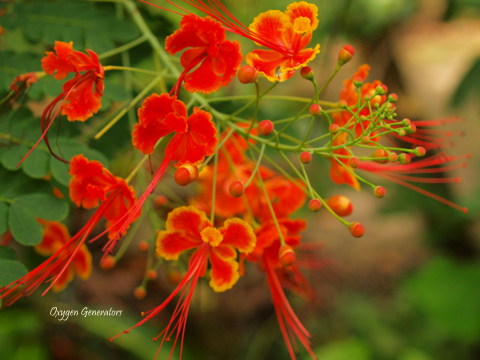These photos are take last month at the midst of our rainy season! In a month or two we are again entering our dry season, when most of the greens will turn brown.
Some plants in our property already bloom a few weeks after the rainy season started. These are mostly the annuals. And there are also the perennials which bloom rain or drought, although of course more and bigger blooms appear during the rainy season.
Hedychium philippinense (Synonym: H coronarium), called kamia or camia in the Philippines, or white ginger in some countries, is a sweet scented flower of the ginger family. The vegetative parts above ground dry up during the dry season and the underground rhizome sprouts again after the first heavy rains. One month of rains is enough for it to produce these blooms.
Every stem of the Hedychium has a bunch of white, sweet smelling, butterfly-shaped flowers sending a lovely scent around the garden. Its smell is not as offensive as the Dracaena fragrans, that we also have plenty around our area, but blooms in the dry season.
Due to its almost succulent stems and leaves, it cannot withstand our dry season, but in covered nurseries they perform well. In our property it seeds profusely because even if we collect them, we just see the growing seedlings as soon as the rains come. We just transfer some of them in pots with more organic soil. It easily breaks when left in the ground due to cats or chickens walking around. Chrysothemis pulchellia.
A single red rose in the midst of caladium leaves look special. Our rose doesn't get special attention too in terms of the soil. It is just left untended but it can tolerate our dry season. We just prune the spent twigs and despite the unhealthy looks, it also sends some blooms.
Turnera subulata in front of the red salvia makes a nice frame.
Our kamantigi, Impatiens balsamina, thoroughly died during dry months. They seed profusely though, and emerge invasively when the rains come. We don't collect their seeds, and whatever emerge will be what we will tend. Last year we have the beige single petals, and the red double petals. However, only this pink doubles was able to survive and grow this year.
The cat whiskers, Orthosiphon aristatus, almost died during the dry months. But the main trunk continued to live and was able to regain strength and beauty with the rains.
The 'Pride of Barbados', better known as Caesalpinia pulcherrima, never fails to give warmth to our hedges. It also hosts the yellow small butterflies, so they are always around to give the area an enchanting look. The small yellow butterflies look like small fairies, which are slow fliers unlike the bigger ones.
These are the new growths of Sanchezia speciosa after severe pruning in July. These are some of the perennials. But it returns well with the continuing rains. I cut all the stems to allow the red Ixora coccinea see some sunlight. The dwarf Ti plant, which was almost fully covered earlier, also benefited from the Sanchezia pruning.
The croton's leaves all drooped throughout the dry months. I did not cut it, and fully recovered with long leaves after the rains.
The good growth of the crotons is prominently displayed through the bright colors and long leaves, almost doubled the length of the dry season leaves.
But the most conspicuous for humans and butterflies are these marigolds. Humans just want to look at them but insects wanted to sip its nectar and get their pollen. It has a smell not really favored by human nostrils, and it leaves a bad taste when you happen to touch them. Butterflies and insects maybe want them bitter, or they really just didn't have the nose! So i just content myself watching both the plants and the butterflies, it is a double treat!


















Those white ones smell sweet I know! Lovely colection of pics.
ReplyDeleteAs usual, a beautiful selection of pictures. Lovely, lovely plants and flowers! Regards, Karmi
ReplyDeleteA whole universe.
ReplyDeletePlease have a good Friday.
daily athens photo
Beautiful pictures of special flowers, so many interesting colors and textures and plants! Thank you for sharing their special powers
ReplyDeleteVery pretty Andrea. Rain always makes them more saturated and shiny. Plus, in the little droplets you get more little pictures!
ReplyDeleteI love that shot of the rose with the caladiums as well....nice reds! The Pride of Barbados is the proper name for the plant the Americans call Mexican Bird of Paradise. I don't understand why they switched the name but this plant thrives here in our climate. It's native to Barbados and secretly I'm glad we can grow them here:)
ReplyDeleteI don't normally use common names because they are as many as there are gardeners! The best to avoid confusion is using Scientific names. They are already here since my time began, or even before my parents did!
Deletei love the cat whiskers---i don't see them around here but there's plenty at my grandfather's farm in the province. great shot of the turnera subulata.
ReplyDeleteSanchezia
Lovely blooms!
ReplyDeleteRed Gumamela
gorgeous! have a great weekend!
ReplyDeletehi Andrea. i think your message about the orange-tinted mother of thousands was in my Live in the Moment blog--it's the current header image.:p edited the original photo in photoshop.
ReplyDeletere my SWF post, it was taken in Busuanga from Mt. Tapias.
Haha thanks Luna, i got mixed-up! I haven't been to Mt Tapias but my friends photo from there are truly spectacular especially before sunrise!
DeleteThose are some beautiful flowers. Enjoy your Friday.
ReplyDeleteBeautiful blooms indeed. You captured them perfectly.
ReplyDeleteThanks for dropping by. You're right, I should give more info in my post. The view captured in Ciwidey - below Mt. Patuha, West Java Province, Indonesia.
Hi! Beautiful captures. All of your photos except red hibiscus are very nice. I like the cat whiskers very much. Wishing you a good weekend.
ReplyDeleteAll are pretty!
ReplyDeleteI always love looking at the flowers and foliage of your natives as I can only grow them indoors or in summer for a short time...just lovely as always especially with their wet coats.
ReplyDeleteIt looks like a tropical paradise!
ReplyDeleteWonderful selection of beautiful flowers.
ReplyDeleteI enjoyed this post very much with all the photos of beautiful flowers and the interesting information. Thank you for sharing. From Denise at Today's Flowers.
ReplyDeleteWonderful flowers! I especially like the crotons.
ReplyDeleteEvery time I look into your plants and flowers, i feel closer home. Thanks. They are beautiful.
ReplyDelete